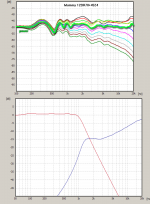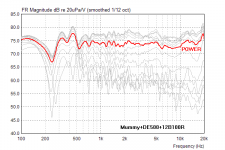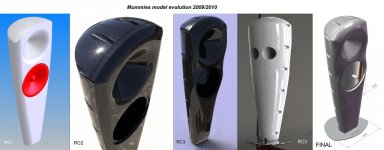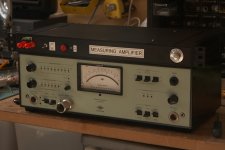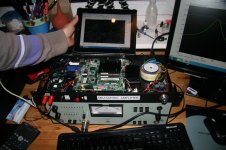Autotech listened FP10 vs. fiberglass SEOS-10, hard to tell difference. Maybe there's an audible difference when one use waveguide/horn below 1kHz. Poured when knocked is like stone means stiffer and this is what you see on spectrogram.
Ah yes, the stiffer the material the more HF-resonances and less MF(towards LF) ditto. I'm suprised though it's not really audible in the HF-region going by the measurements, even when it's above 10kHz, but indeed - it's perhaps more likely the <1kHz resonances would trigger the more audible reaction, if this area was "in use."
Last edited:
Today I could measure:
http://www.diyaudio.com/forums/group-buys/166312-waveguides-horns-116.html#post3071026
http://www.diyaudio.com/forums/group-buys/166312-waveguides-horns-116.html#post3071026
Attachments
I'd say that curve looks extremely well behaved upwards of 500Hz, particularly to 5kHz, with the lower frequencies (especially the ~250Hz dip, as mentioned by DJNUBZ) marred by early room reflections perhaps? At least these irregularities seem to roughly resemble the measurements made on the BMS4524/12BR70 Mummy's, only placed a bit lower on the spectrum, hereby indicating perhaps the same measurement-related problems in this area.
Looking a bit closer, not that it may be of any importance, there's a "mild" tendency in the region 5-10kHz(initiated by a slight diaphragm break-up, perhaps?) and some excess energy above 15kHz - I wonder how that will translate sonically, if at all noticable..
Overall, and if the measurements are anything to go by, this appears to be a very well "weighed" sound. What are the cross-over details - any EQ, etc? Will this be the final cross-over design, or is it a work-in-progress?
Last edited:
250Hz is a floor bounceCrossover has two notches: 320Hz, 2.5kHz. From the beginning I like the sound it's smooth. Now will assemble second unit.
Sounds promising. Do get back with impressions once they're both up and running
Last edited:
jzagaja, could you help?
I'm trying to order the Raal SEOS from the website but it won't let me complete the order because no shipping quote is available. I've tried emailing them but have had no response after a few weeks.
Fiberglass SEOS-raal? - SEOS? Products - Waveguides DIY Sound Group
Are these actually available? (i'm in the uk). Has anyone tried them with the Raal?
thanks!
I'm trying to order the Raal SEOS from the website but it won't let me complete the order because no shipping quote is available. I've tried emailing them but have had no response after a few weeks.
Fiberglass SEOS-raal? - SEOS? Products - Waveguides DIY Sound Group
Are these actually available? (i'm in the uk). Has anyone tried them with the Raal?
thanks!
Now it's been three years that I know Autotech, small anniversaryBellow evolution of Mummy (winter 2010).
Congrats, Jack
Now, let's see if Mummy v3 can up the ante of the bar set indeed quite high by the v2's, although the v3's will have to do damn well - inasmuch I'll be able to assess your impressions of them to begin with, having something to go by - if they're to push down the v2's of their pedestal.
I find it hard to believe the B&C DE500(of v3, if it remains) can top the BMS 4524(of v2) - the latter is really that good; just extremely resolved, dynamic, relaxed, natural, and full/organic. I can't really find anything to complain about with this unit's handling of its entire frequency spectrum(~1.5-20>kHz). And the more I've been playing music through the v2's the better they slowly continue to be.
It's the 12B100/R(of v3) that puts the sweat on my forehead(combined with the lower cross-over to the DE500). The 12BR70(of v2), despite the high-ish cross-over of ~1.5kHz, mates very smoothly with the 4524, possessing a nicely balanced, deep when called for, natural, and agile sonic quality. Bass notes are easily followed through the deep/central to upper areas, maintaining their character, and the lower to central mids are noteworthy of being of a slightly though pleasantly warm, present, and full nature - bereft perhaps subtly of some minute detail here. It's in this rather vital area particularly, the lower to central mids, that I suspect the very low distortion 12B100/R unit(again, combined with the lower cross-over) could better the v2's. Moreover, how does the more powerful magnet and larger voicecoil(4" vs 2") translate with regard to bass reproduction? The 12BR70 is no slouch and can pound away very tightly with great detail and information, but the 12B100/R is a mean "schallmaschine," as the Germans say.
Time will tell - do let us know, Jack, how you think the v3's perform once they're up and running...
Last edited:
An example of measuring jig inside 1U rack housing (ABS), Intel DN2800MT board, M-Audio Transit soundcard and LM3886 amp (PM-40C). Remotely controlled via Ipad. Later I will add USB rotating table. Impedance plot of AFR 85mm unit.
Attachments
are you still going to do a fiberglass version of the SEOS horn in 24" or larger with 1.5" or 2" throat?
I've got a bunch of JBL 2446 and 2447 CDs sitting around waiting on some good waveguides to use with them
I'm not convinced the JBL specific horns I have are the best options. I'd like some big SEOS options... might even have to try one of those Iwatas as well...
I've got a bunch of JBL 2446 and 2447 CDs sitting around waiting on some good waveguides to use with them
I'm not convinced the JBL specific horns I have are the best options. I'd like some big SEOS options... might even have to try one of those Iwatas as well...
- Home
- Group Buys
- Waveguides and horns
